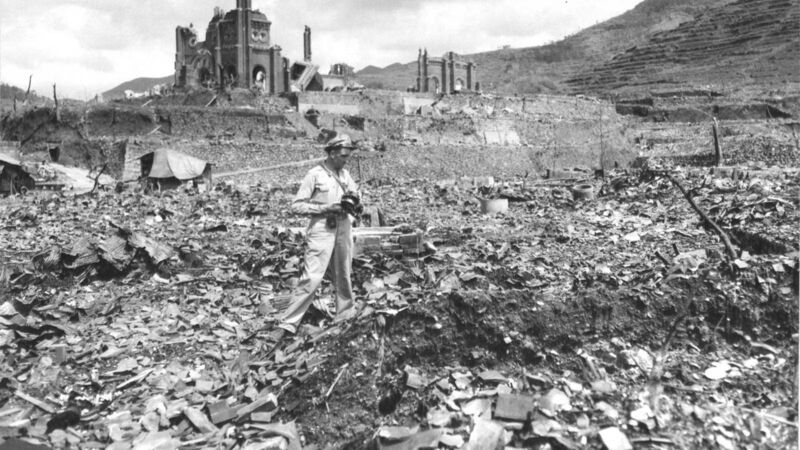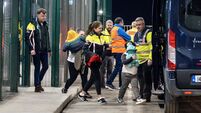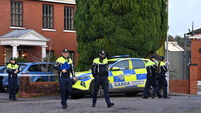Daniel A McGovern: The Irishman who filmed the aftermath of the Nagasaki atomic bomb

Lt Daniel A McGovern pictured with his camera at Ground Zero amid the devastation of Nagasaki on September 9th , 1945. He was one of the very first Americans into the ruined city. Picture: US National Archives.
As one Irishman, Cillian Murphy, portrays the physicist and so-called father of the atomic bomb in Oppenheimer, released in cinemas today, recall another Irishman who was the first to film the real-life devastation it caused.
Daniel A McGovern, a native of Carrickmacross, Co Monaghan, was among the first to enter Japan after its surrender in 1945 where he saw how two cities, Hiroshima and Nagasaki, had been annihilated by a nuclear bomb four weeks earlier.
McGovern, a cameraman with the US Army Air Force, later said that it was as if “a massive anvil” had flattened Nagasaki.
He filmed and photographed the harrowing aftermath — the bodies of children, the shadows of people who had been atomised by the bomb, a boy (16) whose “whole back just looked like a bowl of bubbling tomatoes”, and the landscape, bleached white.
Some 200,000 people died in the nuclear attack while tens of thousands more died due to radiation sickness.
As a member of the US Strategic Bombing Survey, Lt Daniel McGovern directed Japanese and American camera crews as they recorded the apocalyptic scenes around them.
More than that, without him much of the disquieting evidence of nuclear fallout might be lost.
An America fearful of a public backlash tried to suppress the footage, but McGovern safeguarded the archive by making secret copies of photographs as well as some 100,000 ft of colour footage and 26,000 ft in black and white.
There is a moment in Oppenheimer when some of the early footage is shown to those working at the Los Alamos Laboratory, where a team of physicists worked secretly with the blessing of US President Franklin D Roosevelt to develop a nuclear bomb.

J Robert Oppenheimer (Cillian Murphy) looks away in horror, aware of the implications of his powerful creation.
“Now I am become Death, the destroyer of worlds,” Oppenheimer said in real life, and the line from a Hindu sacred text is a leitmotif in Christopher Nolan’s three-hour film.
The film, a sustained assault on the senses, does not ignore the truth of that, but the story is complex and layered and satisfyingly told from several perspectives.
Arguably the most important of those — the human cost of nuclear war — has been preserved for future generations thanks to Daniel McGovern, or Big Mack as his Air Force colleagues nicknamed this man who stood at 6ft 5.
In turn, Irish journalist Joseph McCabe has brought the story of McGovern to a wider audience in his meticulously researched biography, Rebels to Reels.
As McCabe has pointed out, Daniel McGovern preserved the material that represents the definitive film-and-photographic aftermath record we have today of the only time in history that atomic weapons have been used in warfare.
“He was a recorder of history and he was one of best in my opinion,” he said.
McGovern was recently honoured in his native county where a plaque was unveiled to him next to the former RIC station where the family lived during their time in Carrickmacross. The son of an RIC sergeant, he later emigrated with his family to America where he joined the US Air Force.
Meanwhile, Cillian Murphy portrays Oppenheimer’s tortured regret in a breathtaking performance. He warns of the folly of a nuclear arms race, but it was Irishman Daniel McGovern who showed the world what weapons of mass destruction can do to the human race.











